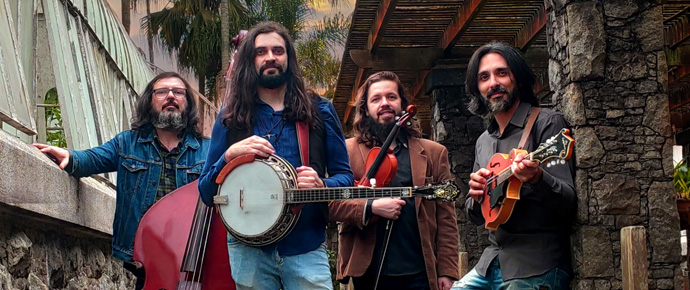
o Bardo e o Banjo may be starting a new trend, at least as far as the connection between Brazil and bluegrass is concerned. Now celebrating the ten year anniversary of their founding, a happy occurrence that resulted from Wagner Creoruska’s street performances on the streets of São Paulo, playing solo on banjo and a bass drum suitcase. “It was through these street performances that it all started, and I got to know the band members,” Creoruska recalls. Eventually, a band emerged from those early connections, one that includes Creoruska on banjo, Marcus Zambello on fiddle, Rodrigo Rossignol on mandolin, and Ivan Valle on acoustic bass.
With that, o Bardo e o Banjo was born.
Nevertheless, the band was fueled by some unlikely early influences. “Bluegrass is not all that popular here in Brazil,” Creoruska insists. “The first time I heard bluegrass was in 2007. It was a band called Hayseed Dixie, a band that adapts bluegrass music from the music of classic rock ‘n’ roll bands like AC/DC. That’s how I first encountered this sound and fell in love with it. After that, I started researching, and that was when I found the true originators of the style, like Bill Monroe, Earl Scruggs, J.D. Crowe, Tony Rice, and so many other bluegrass icons.”
That led Creoruska and his compatriots to create their own variation on the style, one they adapted as their own. “We make our own songs that mix bluegrass with our regional music here in Brazil,” he explains. “It’s called ‘música caipira’ and ‘moda de viola.’ There are many commonalities in these two music styles and we enjoyed exploring this junction a lot. In addition, we really enjoy playing traditional bluegrass tunes, and even some bluegrass versions of classic rock n roll songs. So what we have in the end is a great mix of different styles, but with bluegrass always as our starting point and the kind of music we love.”
In fact, the love seems to be mutual between the band and its followers. o Bardo e o Banjo has played extensively throughout their native Brazil, including such cities and states as Paraná, Santa Catarina, Rio Grande do Sul, Minas Gerais, Rio de Janeiro, and others in a combination of various venues that include pubs, music festivals, and private events.
In the process, the band has had the opportunity to perform with other important Brazilian bands, among them, Supercombo, Tuatha de Danann, and Terra Celta.
“Bluegrass is a very captivating style of music and Brazilians really like the sound of bluegrass, even without knowing the songs we play,” Creoruska maintains. “We’ve had the opportunity to play on several television shows, and we always receive many messages from people saying that they got to know bluegrass through our performances, and that they are delighted with this musical style.”
Not surprisingly then, the group has proven to be particularly popular on the local festival circuit, with Creoruska citing such gatherings as Lollapalooza 2015, Psicodália 2015, Odin’s Krieger Fest 2016, Virada Cultural Maringa 2016, Rodeo Motorcycle 2017, 2018, and 2019, BMS Motorcycle 2018, Capital Moto Week 2019, and Oxigênio Festival 2019 as those that have featured them so far. “We were also invited to play at the John Hartford Memorial Festival in Indiana, in 2015, but unfortunately we couldn’t go because of a problem with our American visas,” he calls. “We went to Chicago, but we had to go back home to Brazil, and unfortunately, we didn’t have time to get the visas and go back to the festival.”
In the meantime, o Bardo e o Banjo has tallied four albums in total, two featuring their own material and the other two containing covers. “Our last album is called O Tempo e a Memória,” Creoruska says. It’s a very cool curiosity is that we started singing in Portuguese on this album.”
The albums are available on various digital platforms such as Spotify, Apple Music, Amazon.
Creoruska notes that the album more or less align to their MO. They perform their own original material, but also play cover songs as well.
Consequently, Creoruska is able to offer his own thoughts as to why bluegrass boasts an international following.
“Bluegrass is a passionate music style,” he notes. “It reminds us of many good things, like life in the country and the joys of being able to get together and jam with friends. It’s a sound that conveys that joy to all kinds of people.”







